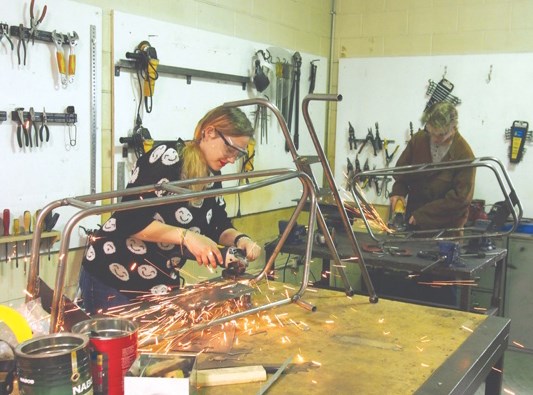It’s 9 o’clock on a Friday morning in the shop room at École McIsaac School, and there isn’t an idle hand in sight. The nine Hapnot Collegiate students enrolled in the grade 11 metals and fabrication class are engrossed in completing a semester-long project: creating their own, fully functional, motorized mini bikes.
Colin Davis, vocational education department head at Hapnot, said the project is one he has been hoping to integrate into the school division’s metals curriculum for a long time. When Joel Gamache was hired as the course teacher for the 2015-16 school year, the timing was perfect. “Joel was on board from the beginning,” Davis said.
That was a good thing, because the mini bike project has required a huge commitment from the two teachers, who stay after school from 4 to 6 on most school days to provide students with extra time in the shop to get ahead on their bikes.
Davis and Gamache also designed the bike prototype themselves, experimenting until they got each part just right. Gamache notes that the design of the bike keeps Flin Flon’s weather in mind, as the wheels can be switched out for tracks and a ski, converting it into an ice bike.
After the metals students had built a foundation of knowledge in basic welding skills, each student began manufacturing his or her own bike with the teachers’ guidance, building most parts from hand, from the threads for the axles to the seat upholstery.
Student Jarrett Oulette, whose bike is nearly complete, said the most challenging part of the process was bending the metal tubing to create the bike’s frame. The task required precision and concentration, as students used a pneumatic tubing bender to bend the pipe at just the right angles to match the bike prototype.
While the school does not provide motors for the bikes, students have purchased their own, or, in many cases, repurposed motors from other machines, like snow blowers, and have worked with Gamache to get the motors running smoothly.
Gamache says each bike, when it’s complete, will be worth close to $500 just in the cost of parts – but for students, the value is much greater.
“They get to leave with something far better than anything else built in the province at this grade level,” Davis said. “They get to reap the rewards of their hard work.”
The project seems to be motivating more students to try out the trades-based class: Gamache said enrollment in the class increased from four students to nine almost overnight, once word of the mini bike project got around the school.
He said much younger students have also expressed interest in taking the class in the future, and current students are already exploring career options to build on their new-found skills.
“Quite a few of them have expressed interest in getting into a manufacturing trade, be it machining or welding,” Gamache said.
Whether or not the students take the leap from a high school class to a career in the trades, the hands-on skills they’ve learned, and the shiny new bikes they’ll take home, will likely stay with them for years.




